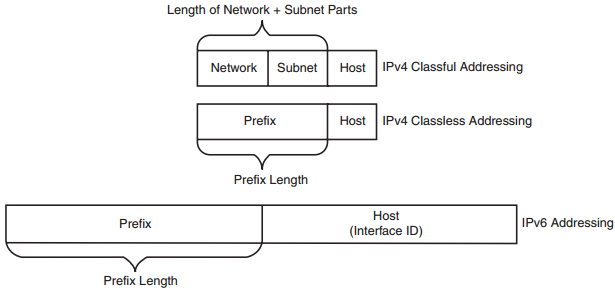CCNP Route FAQ: IP Version 6 Addressing

Figure: IPv4 Classless and Classful Addressing, IPv6 Addressing
Q1. Which of the following is the shortest valid abbreviation for FE80:0000:0000:0000:0010:0000:0000:0123?
a. FE80::10::123
b. FE8::1::123
c. FE80:0:0:0:10::123
d. FE80::10:0:0:123
Q2. An ISP has assigned prefix 3000:1234:5678::/48 to Company1. Which of the following terms would typically be used to describe this type of public IPv6 prefix?
a. Subnet prefix
b. ISP prefix
c. Global routing prefix
d. Registry prefix
Q3. Which of the following answers lists either a protocol or function that can be used by a host to dynamically learn its own IPv6 address? (Choose two.)
a. Stateful DHCP
b. Stateless DHCP
c. Stateless autoconfiguration
d. Neighbor Discovery Protocol
Q4. Which of the following is helpful to allow an IPv6 host to learn the IP address of a default gateway on its subnet?
a. Stateful DHCP
b. Stateless RS
c. Stateless autoconfiguration
d. Neighbor Discovery Protocol
Q5. Which of the following answers lists a multicast IPv6 address?
a. 2000::1:1234:5678:9ABC
b. FD80::1:1234:5678:9ABC
c. FE80::1:1234:5678:9ABC
d. FF80::1:1234:5678:9ABC
Q6. Router R1 has two LAN interfaces and three serial interfaces enabled for IPv6. All the interfaces use link local addresses automatically generated by the router. Which of the following could be the link local address of R1’s interface S0/0?
a. FEA0::200:FF:FE11:0
b. FE80::200:FF:FE11:1111
c. FE80::0213:19FF:FE7B:0:1
d. FEB0::211:11FF:FE11:1111
Q7. Router R1 has the following configuration. Assuming R1’s F0/0 interface has a MAC address of 0200.0011.1111, what IPv6 addresses will R1 list for interface F0/0 in the output of the show ipv6 interface brief command?
interface f0/0
ipv6 address 2345:0:0:8::1/64
a. 2345:0:0:8::1
b. 2345:0:0:8:0:FF:FE11:1111
c. FE80::8:0:FF:FE11:1111
d. FE80:0:0:8::1
Q8. Router R1 lists the following output from a show command. Which of the following is true about R1?
R1# show ipv6 interface f0/0 FastEthernet0/0 is up, line protocol is up IPv6 is enabled, link-local address is FE80::213:19FF:FE12:3456 No Virtual link-local address(es): Global unicast address(es): 2000::4:213:19FF:FE12:3456, subnet is 2000:0:0:4::/64 [EUI] Joined group address(es): FF02::1 FF02::2 FF02::1:FF:12:3456
a. R1’s solicited node multicast address is FF02::1:FF:12:3456.
b. R1’s 2000::4:213:19FF:FE12:3456 address is a global unicast with all 128 bits statically configured.
c. Address FF02::2 is R1’s solicited node multicast.
d. R1’s solicited node multicast, not listed in this output, would be FF02::213:19FF:FE12:3456.